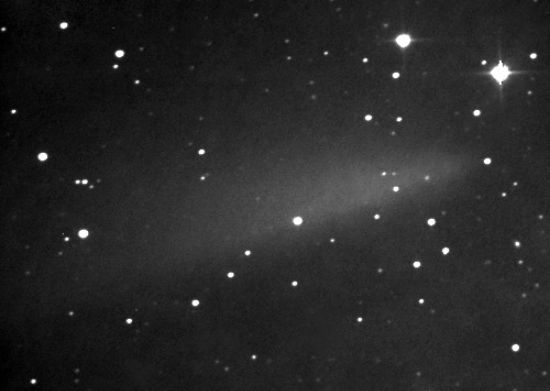
|
Credit & Copyright: Gordon Garradd
Explanation:
Only
last month the stage was set for
Comet
LINEAR (C/1999S4 LINEAR)
to become the first "naked-eye" comet of Y2K.
It didn't fill that role, of course, but it did turn in
a very dramatic performance.
Closely followed by astronomer Mark Kidger and colleagues with the
Isaac
Newton Group telescopes (La Palma,
Canary Islands),
comet LINEAR's nucleus apparently
fragmented extensively on the night of July 25th.
A faint fluorescent cloud fading against a background
of stars is all that is still
visible in this August 21st telescopic view
from
Loomberah, NSW Australia.
Why did comet LINEAR break up?
Comets are conglomerates of
ice and rock.
A very plausible
scenario is
that a substantial fraction of LINEAR's
icy component was evaporated, leaving too little to
hold the rocky material together.
In any event, no bright telltale
condensations remain.
So, following its first tour through the
inner Solar System,
an encore from comet LINEAR
seems unlikely!
|
January February March April May June July August September October November December |
| ||||||||||||||||||||||||||||||||||||||||||||||||
NASA Web Site Statements, Warnings, and Disclaimers
NASA Official: Jay Norris. Specific rights apply.
A service of: LHEA at NASA / GSFC
& Michigan Tech. U.
Based on Astronomy Picture
Of the Day
Publications with keywords: comet - comet linear - C/1999 S4 comet
Publications with words: comet - comet linear - C/1999 S4 comet
See also:
- APOD: 2025 February 5 Á Comet G3 ATLAS Setting over a Chilean Hill
- APOD: 2025 February 2 Á Comet G3 ATLAS Disintegrates
- APOD: 2025 January 28 Á Comet G3 ATLAS over Uruguay
- APOD: 2025 January 26 Á The Many Tails of Comet G3 ATLAS
- Comet G3 ATLAS: a Tail and a Telescope
- APOD: 2025 January 21 Á Comet ATLAS over Brasilia
- APOD: 2025 January 20 Á Comet ATLAS Rounds the Sun
